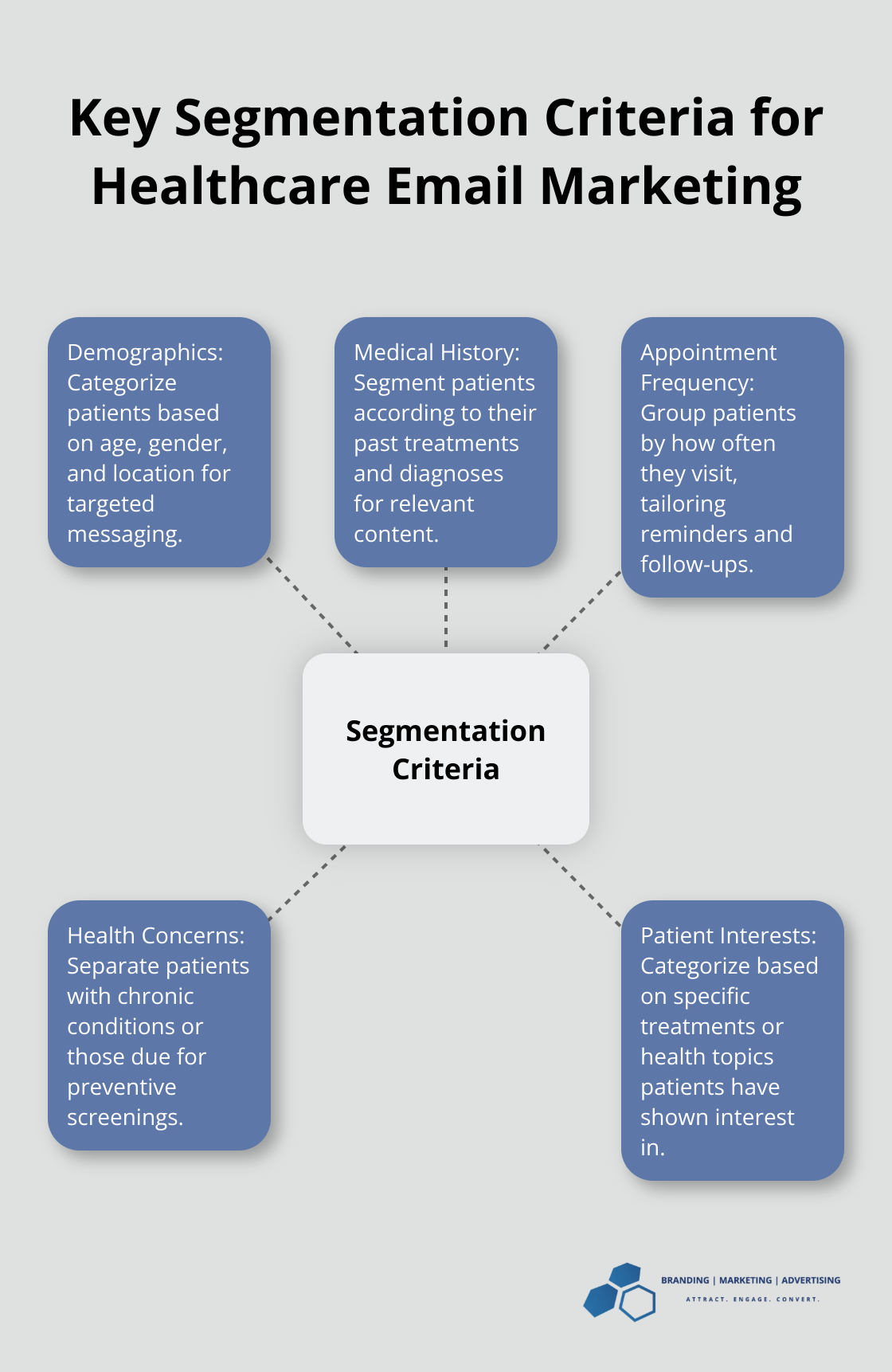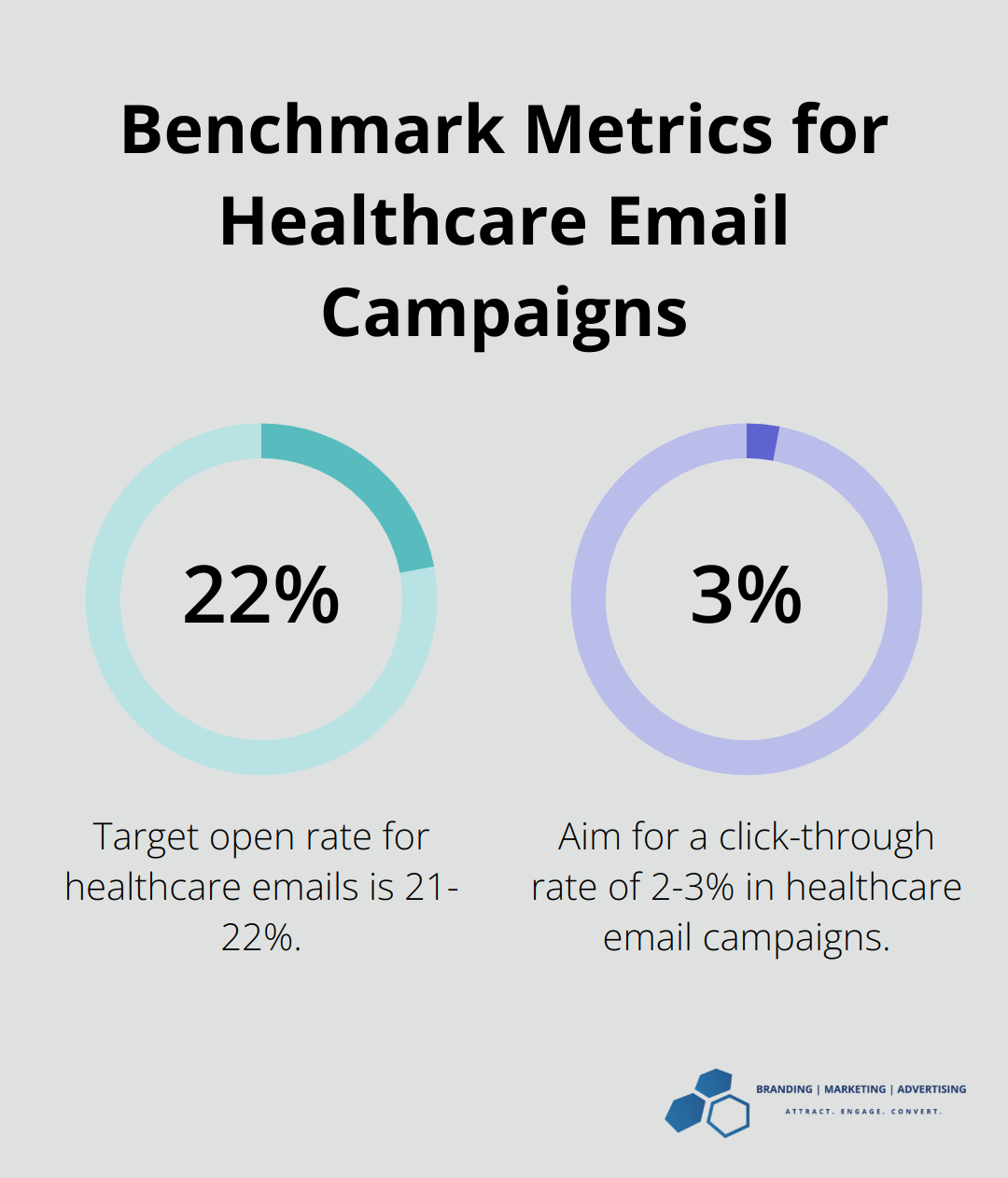How to Optimize Health Care Email Marketing Campaigns
At Branding | Marketing | Advertising, we know that healthcare email marketing is a powerful tool for patient engagement and practice growth.
In this post, we’ll show you how to create effective email campaigns that resonate with your healthcare audience. You’ll learn strategies for crafting compelling content, implementing best practices, and optimizing your campaigns for maximum impact.
Get ready to transform your healthcare email marketing and boost patient relationships.
Who Are Your Healthcare Email Recipients?
Segmentation: The Foundation of Personalized Healthcare Emails
Segmenting your email list forms the foundation of successful healthcare email marketing campaigns. You should categorize your audience based on demographics such as age, gender, and location. Then, you need to analyze their medical history, appointment frequency, and specific health concerns.
Create separate segments for patients with chronic conditions, those due for preventive screenings, or individuals interested in specific treatments. This approach allows you to send highly targeted emails that address each group’s unique needs and interests.

Identifying Patient Concerns and Preferences
To create compelling email content, you must understand what matters most to your patients. You should conduct surveys, analyze website behavior, and review past interactions to identify key concerns and preferences.
Do your patients primarily want preventive care tips? Are they seeking information about new treatments? Do they need ways to manage chronic conditions? Use these insights to shape your email content strategy.
Tailoring Content to Healthcare Specialties
Different healthcare specialties require unique approaches to email marketing. A pediatric practice will have vastly different content needs compared to a geriatric clinic or a mental health facility.
For a pediatric practice, emails should focus on childhood vaccination schedules, developmental milestones, and parenting tips. A geriatric clinic might emphasize fall prevention, medication management, and senior wellness programs. Mental health providers could share stress reduction techniques, information about new therapies, and resources for support groups.
Tailoring your content to specific healthcare specialties ensures that your emails provide maximum value to your recipients. This targeted approach can significantly boost engagement rates and strengthen patient relationships.
Leveraging Data for Personalization
Use the data you collect from patient interactions to personalize your emails further. This could include addressing recipients by name, referencing their last appointment, or mentioning specific health concerns they’ve expressed interest in.
(Remember to always comply with HIPAA regulations when handling patient data.)
Testing and Refining Your Approach
You should continuously test and refine your email marketing strategy. Try different subject lines, email formats, and content types to see what resonates best with your audience. (A/B testing can provide valuable insights into what works and what doesn’t.)
Monitor key metrics such as open rates, click-through rates, and conversion rates to gauge the effectiveness of your campaigns. Use these insights to make data-driven decisions and improve your email marketing efforts over time.
As you move forward with your healthcare email marketing strategy, you’ll need to focus on crafting compelling content that resonates with your segmented audience. Let’s explore how to create informative, engaging, and visually appealing emails that will capture your recipients’ attention and drive action.
How to Create Compelling Healthcare Email Content
At Branding | Marketing | Advertising, we understand the importance of crafting compelling healthcare email content to engage your audience and drive action. Here’s how you can create emails that resonate with your healthcare recipients:
Develop Informative Newsletters
Healthcare newsletters serve as a powerful tool for patient education and engagement. You should provide valuable, actionable information that addresses your patients’ most pressing concerns. Include seasonal health tips, updates on medical research, or explanations of common health conditions.
To enhance engagement, use a mix of content types. Short articles, quick tips, and video content can make your newsletters more appealing. Set a regular schedule to send out your emails; once every two weeks or once a month is a good standard.
Use Visual Elements Effectively
Visual elements can significantly enhance the impact of your healthcare emails. Infographics excel at presenting complex health information in an easily digestible format. Create infographics that illustrate proper hand-washing techniques, explain medical procedures, or show the benefits of a healthy diet.
Incorporating images and GIFs in email marketing not only enhances the aesthetic appeal but also significantly boosts engagement rates. Ensure your visuals are mobile-friendly. Use a responsive design that adapts to different screen sizes, and keep your visuals simple and easy to understand at a glance.

Share Patient Success Stories
Patient testimonials and success stories provide powerful social proof and help potential patients envision positive outcomes for themselves. Focus on specific, relatable experiences that showcase the benefits of your healthcare services.
Always obtain proper consent before sharing any patient information, and adhere to HIPAA guidelines. You can anonymize stories or use composite case studies if necessary to protect patient privacy.
Highlight New Treatments and Services
Your email campaigns offer an excellent platform for introducing new treatments or services. Focus on the benefits to the patient rather than just listing features. Explain how the new offering can improve their quality of life, reduce recovery time, or provide better health outcomes.
For example, when introducing a new minimally invasive surgical technique, highlight benefits like shorter hospital stays, reduced pain, and faster recovery times. Include statistics or study results that support these claims to build credibility.
These strategies will help you create content that engages your audience. The key lies in providing value in every email you send. As you implement these techniques, you’ll notice improved open rates, click-through rates, and ultimately, better patient engagement and outcomes. Now, let’s explore the best practices for healthcare email campaigns to ensure your efforts comply with regulations and maximize effectiveness.
How to Maximize Healthcare Email Campaign Success
At Branding | Marketing | Advertising, we understand the power of effective healthcare email campaigns. Here’s how you can elevate your email marketing efforts:
Ensure HIPAA Compliance
HIPAA compliance is essential in healthcare email marketing. Protect patient privacy in every email you send. Avoid including Protected Health Information (PHI) unless you use a secure, encrypted platform. Focus on general health information and personalized content that doesn’t reveal specific patient details.
Implement strict data handling procedures to maintain HIPAA compliance. Train your staff on proper email practices and use HIPAA-compliant email marketing software. Regular audits of your email processes will help identify and address potential compliance issues.
Create Compelling Subject Lines
Your email subject line is your first chance to grab a recipient’s attention. Keep subject lines concise – under 50 characters is ideal. Use action-oriented language that creates a sense of urgency or curiosity.
“Your annual check-up is due – Book now!” will likely prompt more action than a vague “Health update”. Crafting compelling subject lines is crucial for increasing open rates. Include the recipient’s name or reference their last visit to make your email stand out.
Personalize Your Email Content
Personalization extends beyond using a patient’s name. Use the data you have to tailor content to each recipient’s interests and health needs. For a patient interested in weight management, send relevant tips and information about your nutrition services.
Use dynamic content blocks that change based on the recipient’s profile. This allows you to send one email that appears differently to various segments of your list (saving time while still providing highly relevant content).
Set Up Automated Email Sequences
Healthcare CRM systems improve patient engagement through personalized communication, timely follow-ups, and easier access to health services. Create a series of emails triggered by specific actions or timeframes. After a patient books an appointment, send an immediate confirmation, a reminder a week before, and a final reminder the day before.
Post-visit follow-up emails can enhance patient satisfaction and outcomes. Send a thank you message after the appointment, followed by care instructions or medication reminders if applicable. These automated touchpoints keep patients engaged with your practice between visits.
Test and Analyze Continuously
Long-term success in email marketing requires continuous improvement. Regularly test different elements of your emails to see what resonates best with your audience. Try different subject lines, email layouts, call-to-action buttons, and content types.
Monitor key metrics like open rates, click-through rates, and conversion rates. Try to achieve open rates around 21-22% and click-through rates of 2-3% for healthcare emails. If your metrics fall below these benchmarks, reassess your strategy.

Use A/B testing to compare different versions of your emails. Send two variations to a small portion of your list, then use the winning version for the remainder of your recipients. This data-driven approach ensures your emails become more effective over time.
Remember to keep your emails concise, valuable, and action-oriented. Include a clear call-to-action, such as scheduling a consultation or downloading a free resource. By following these strategies, you can optimize your healthcare email campaigns and drive better results for your practice.
Final Thoughts
Healthcare email marketing empowers patient engagement and practice growth. Effective campaigns require audience understanding, compelling content creation, and best practice implementation. Segmentation, personalization, and HIPAA compliance form the foundation of successful healthcare email strategies.
Engaging newsletters, visually appealing infographics, and patient success stories build trust and provide value to recipients. Compelling subject lines, personalized content, and automated sequences boost engagement rates and streamline communication efforts. Regular testing and analysis (using metrics like open rates and click-through rates) refine your approach for long-term success.
Branding | Marketing | Advertising specializes in optimizing digital marketing efforts for healthcare providers. We can support your healthcare email marketing initiatives and help your practice thrive in the digital landscape. Visit our website to learn more about our services and how we can elevate your email campaigns.












